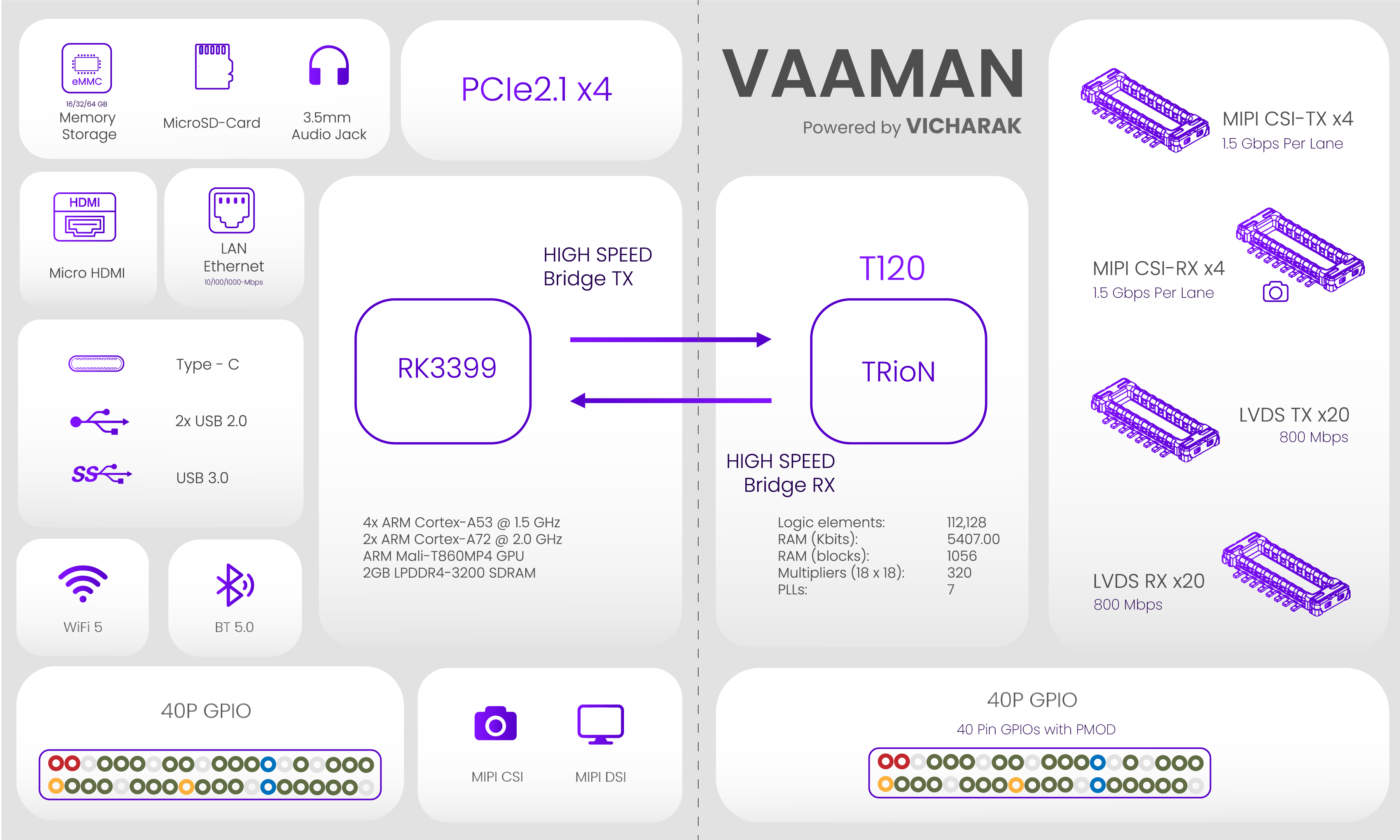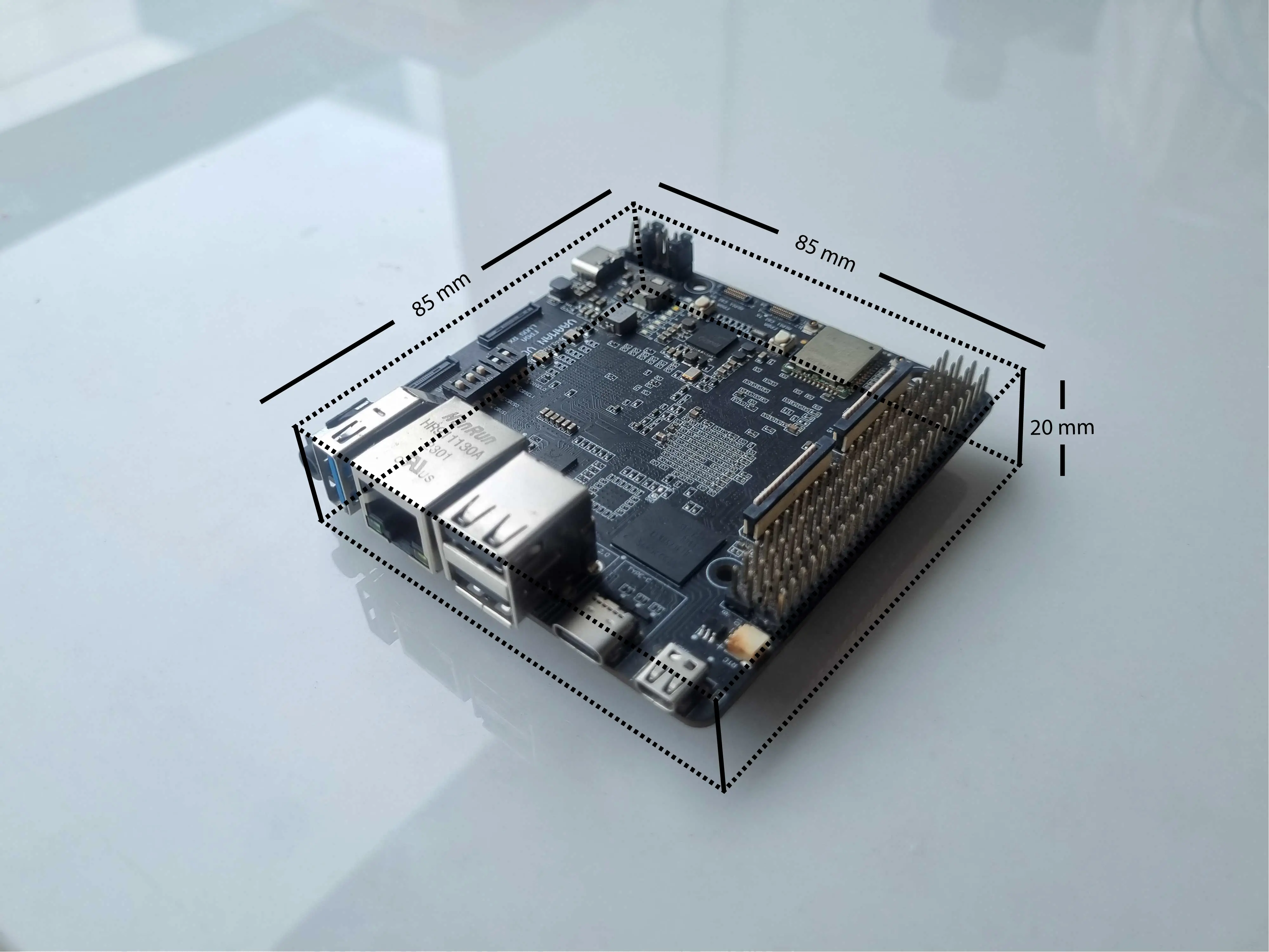Overview
The main idea behind Vaaman is to pick the faster processor than all other SoC series FPGAs (mostly 4-core ARM Cortex-A53 ~ 1.5–1.8 GHz), while Vaaman is (6-core, Cortex-A72 and Cortex-A53, goes up to 2.0 GHz) and somewhat good FPGA, which offers hardened blocks for communication interface + a very good price that we can offer to consumers. Thousands of applications do not need high-end FPGAs, but they need extraordinary normal hardware, which can use both CPUs and FPGAs functionalities. We’ve designed Vaaman in a way that it does not compromise any functionality the other SBCs offer. It has everything: PCIe, SD Card, WiFi+BLE, Ethernet, USB, and a 40-PIN Raspberry Pi header. You can fit any Raspberry Pi HATs directly into Vaaman easily. So, Vaaman will offer everything that the current SBC ecosystem is offering as it is + it has the benefit of the FPGA world natively.
Vaaman’s CPU ↔ FPGA: Bridging the Best of Both Worlds!
Communication link is something that we worked on extensively, as our main goal was not to compromise any interface for CPU and FPGA sides where it has to communicate with the outside world. PCIe is extremely important from the CPU side for many embedded applications, so we wanted to keep it aside, along with other interfaces like MIPI CSI, DSI, USB 3.0 and 2.0, and GPIOs. So what did we do? We chose the hardest routeto get it up. Efinix has a hard block of MIPI CSI, and Rockchip’s RK3399 also had a hard block of camera and display interfaces. It was hard work—we had to tweak the Linux kernel and write wrapper drivers that drop display packets and use raw data packets natively. And that’s it. We are naming this link as RAH Link. (https://github.com/vicharak-in/rah-bit).
Write, Read, Done! Simplifying CPU ↔ FPGA Interaction
Our another goal was to make it very simple to be accessed by both software and hardware front-end. We’ve written API-level drivers in C/C++ and Python, which make it very easy to communicate with it. Write APP_ID, data packets, and length—that’s it. On the FPGA side, FIFOs! Write everything in FIFOs, and you can read it from there. Whether you want to convert it to APB, AHB, AXI, or simple mechanisms, it’s completely up to you!
Who is Vaaman For?
Vaaman is useful to a wide range of users, these include but are not limited to:
- Software Developers:
A significant portion of the user base consists of software developers who utilize the SBC’s FPGA capabilities to optimize software performance, accelerate computations, and explore hardware acceleration.
- Researchers:
Vaaman with its FPGA attracts researchers who leverage its potential for implementing custom algorithms, conducting experiments, and prototyping novel solutions. The FPGA serves as a valuable tool for their research endeavors.
- Hardware Designers:
The SBC appeals to hardware designers as it provides a platform for developing and testing hardware designs. They can use the FPGA to prototype and verify their designs efficiently, enabling rapid iterations.
- Hobbyist Users:
The SBC also attracts ordinary users with an interest in tinkering and learning about cutting-edge technologies. They can utilize the SBC’s versatility for various projects such as robotics, home automation, and DIY electronics.
Block Diagram

Features
The Vaaman Single Board Computer (SBC) offers a range of hardware features, including:
Type |
Feature |
|---|---|
Display |
1 x HDMI 2.0 (Micro), Support maximum 4K@60Hz display
1 x MIPI, Support 2560x1600@60fps output with dual channel
1 x USB-C DP, Support maximum 4K@60Hz display
|
Audio |
3.5mm jack with mic |
Ethernet |
10/100/1000Mbps Ethernet (Realtek RTL8211E) |
Camera |
MIPI CSI 2 lanes via FPC connector, support up to 800MB/s bandwidth |
Wireless |
Integrated RTL8822CS Wi-Fi and BT Combo Module (6222B-SRC) WiFi 2.4G+5G WiFi 2T2R BT5.0 |
PCIe |
PCIe Interface via FPC connector |
USB |
2x USB2.0 HOST
1x USB3.0 HOST/OTG
1x USB Type-C (USB3.0 / DP Alt mode)
|
RTC |
Support RTC, on-board backup battery interface |
I/O |
1 x UART
2 x SPI bus
2 x I2C bus
1 x PCM/I2S
1 x SPDIF
1 x PWM
1 x ADC
21 x GPIO
2 x 5V DC
2 x 3.3V power pin
|
FPGA |
Efinix® T120F324 device in a 324-ball FineLine BGA package.
DRAM Chip DDR3 SDRAM 4Gbit 256Mx16 1.35V/1.5V.
128 Mbit SPI NOR flash memory.
MIPI-CSI RX connector with 4 data lanes and 1 clock lane.
MIPI-CSI TX connector with 4 data lanes and 1 clock lane.
LVDS Transmitter interface connector that supports 20 Lanes.
LVDS Receiver interface connector that supports 20 Lanes.
JTAG headers for configuration.
User selectable voltages from 1.8 V, 2.5 V, and 3.3 V for bank 1B, 1C, and 2F.
40-pin GPIO header supported with 12-pin 1 PMOD and 2 LVDS lane or 25 GPIOs.
10, 20, 25, 30, 50, and 74.25 MHz oscillators for T120F324 PLL input.
4 User LEDs on T120F324 bank 2F.
|
Dimensions

Physical Specifications
Specifications |
Value |
|---|---|
Weight |
60 grams |
Length |
85 mm |
Breadth |
85 mm |
Height |
20 mm |
Tip
For more information on the Vaaman GPIOs, see Vaaman GPIO Description